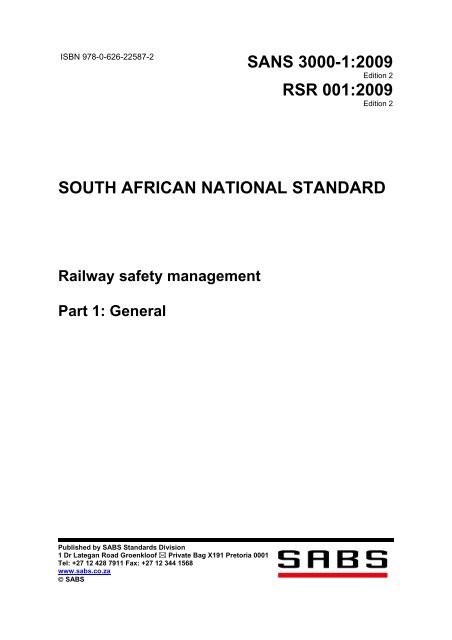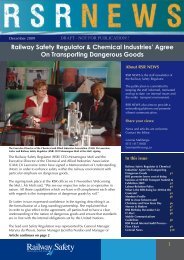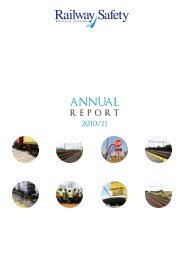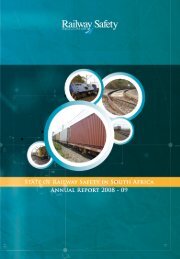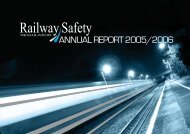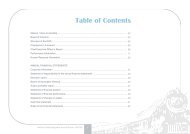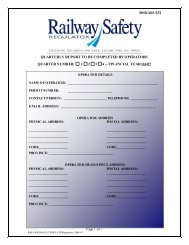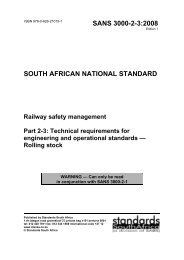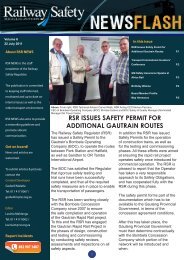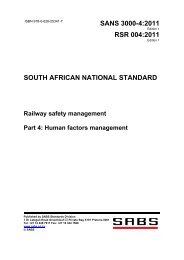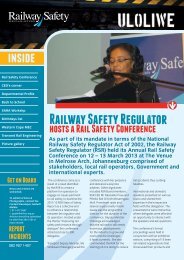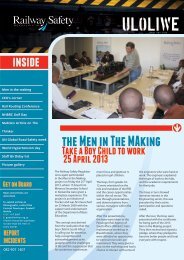SANS 3000-1:2009 - Railway Safety Regulator
SANS 3000-1:2009 - Railway Safety Regulator
SANS 3000-1:2009 - Railway Safety Regulator
- No tags were found...
Create successful ePaper yourself
Turn your PDF publications into a flip-book with our unique Google optimized e-Paper software.
ISBN 978-0-626-22587-2<strong>SANS</strong> <strong>3000</strong>-1:<strong>2009</strong>Edition 2RSR 001:<strong>2009</strong>Edition 2SOUTH AFRICAN NATIONAL STANDARD<strong>Railway</strong> safety managementPart 1: GeneralPublished by SABS Standards Division1 Dr Lategan Road Groenkloof Private Bag X191 Pretoria 0001Tel: +27 12 428 7911 Fax: +27 12 344 1568www.sab s.co.za© SABS
<strong>SANS</strong> <strong>3000</strong>-1:<strong>2009</strong>Edition 2Table of changesChange No. Date ScopeAcknowledgementThe SABS Standards Division and the <strong>Railway</strong> <strong>Safety</strong> <strong>Regulator</strong> wish to acknowledge the valuableassistance of the following organizations in the preparation of this document:a) Transnet Limited;b) the Passenger Rail Agency of South Africa (PRASA);c) the Heritage <strong>Railway</strong> Association of South Africa;d) the Railroad Association of South Africa;e) Standards Australia;f) Transport Canada; andg) Bombela Concession Company (Pty) Ltd.ForewordThis South African standard was approved by National Committee SABS TC 1066, Nationalsteering committee for railway safety standards, in accordance with procedures of the SABSStandards Division, in compliance with annex 3 of the WTO/TBT agreement.This document was published in XXXX <strong>2009</strong>. This document supersedes <strong>SANS</strong> <strong>3000</strong>-1:2005(edition 1).<strong>SANS</strong> <strong>3000</strong> consists of the following parts, under the general title <strong>Railway</strong> safety management:Part 1: General.Part 2-1: Technical requirements for engineering and operational standards – General.Part 2-2: Technical requirements for engineering and operational standards – Track, civil andelectrical infrastructure.Part 2-3: Technical requirements for engineering and operational standards – Rolling stock.Part 2-4: Technical requirements for engineering and operational standards – Train authorizationand control systems and equipment. (In course of preparation.)Part 2-5: Technical requirements for engineering and operational standards – Train operationsmanagement. (In course of preparation.)Part 2-6: Technical requirements for engineering and operational standards – Interoperability, intermodaland utilities management. (In course of preparation.)
<strong>SANS</strong> <strong>3000</strong>-1:<strong>2009</strong>Edition 2Part 3: <strong>Railway</strong> occurrence management. (In course of preparation.)Part 4: Human factors management. (In course of preparation.)Part 5: <strong>Railway</strong> stations. (In course of preparation.)Reference is made in 1.3 and 3.1.2 to the "relevant national legislation". In South Africa this meansthe National <strong>Railway</strong> <strong>Safety</strong> <strong>Regulator</strong> Act, 2002 (Act No. 16 of 2002) (as amended from time totime).Reference is made in clause 3, 5.2.1 and 8.2 to the "relevant national railway safety legislation". InSouth Africa this means the National <strong>Railway</strong> <strong>Safety</strong> <strong>Regulator</strong> Act, 2002 (Act No. 16 of 2002) (asamended from time to time), and the <strong>Railway</strong> <strong>Safety</strong> Standards Development Regulations.Reference is made in 5.2.1 to the "relevant national health and safety legislation". In South Africathis means the Occupational Health and <strong>Safety</strong> Act, 1993 (Act No. 85 of 1993) (as amended fromtime to time) and the Mine Health and <strong>Safety</strong> Act, 1996 (Act No. 29 of 1996) (as amended from timeto time).Reference is made in 5.2.2, 5.5.1, 5.5.3, 5.5.7, 5.6.1.3, 5.8.6, 5.9.1, 6.3.4, 6.4, 7.2.1, 7.6, 8.6, 9.2,10.1.1, 10.2.1, 10.3.2, 11.1.2, 11.2, 14.1, clause 16 and annex E to the "relevant national railwaysafety regulator". In South Africa this means the <strong>Railway</strong> <strong>Safety</strong> <strong>Regulator</strong> (RSR).Reference is made in 5.6.1.3 and 5.8.7 to the "relevant national legislation". In South Africa thismeans the National Archives and Record Service of South Africa Act, 1996 (Act No. 43 of 1996).Reference is made in 5.7.2 to the "relevant national railway safety regulations". In South Africa thismeans the <strong>Railway</strong> <strong>Safety</strong> Standards Development Regulations.Reference is made in 7.5.1 to the "relevant national health and safety legislation". In South Africathis means section 24 of the Occupational Health and <strong>Safety</strong> Act, 1993 (Act No. 85 of 1993) (asamended from time to time).Reference is made in 10.1.1 to the "relevant national authorities". In South Africa this means theSouth African Police Services (SAPS) (including the <strong>Railway</strong> Police Division, local SAPS units, theGovernment Security <strong>Regulator</strong> (GSR)), and the Chief Inspector of Explosives (CIE).The previous edition of this document was supplementary to the <strong>Railway</strong> <strong>Safety</strong> ManagementRegulations of 2004, which were developed in accordance with the National <strong>Railway</strong> <strong>Safety</strong><strong>Regulator</strong> Act, 2002 (Act No. 16 of 2002) (as amended from time to time). This edition has beendeveloped in accordance with the National <strong>Railway</strong> <strong>Safety</strong> <strong>Regulator</strong> Amendment Act, 2008 (ActNo. 69 of 2008), which repealed the Regulations of 2004.Annexes D and E form an integral part of this document. Annexes A, B and C are for informationonly.IntroductionThis document has been developed primarily with a view to achieving uniformity in the managementof railway safety both as a general principle and with specific reference to the issuing of safetypermits to railway operators.Key to railway safety management is an appropriate risk management system that aims to ensurethat railway operators identify their technical and operational hazards and manage the resultantrisks to people, property and the environment to a level that is as low as is reasonably practicable.1
<strong>SANS</strong> <strong>3000</strong>-1:<strong>2009</strong>Edition 2This approach recognizes that, while there is an ideal level of safety, the costs of achieving thisideal might far outweigh the benefits and limit the viability of railway operations. However, it isunderstood that railway operators protect their commercial and social responsibilities by runningsafe railways.<strong>Railway</strong> safety has a relationship with workplace health and safety, and with security, both of whichare governed by specific legislation. The safety management system is required to take intoaccount the impact of occupational health and safety issues as well as security matters on railwayoperational safety.This document outlines a common approach to the management of the interfaces betweenoperators and intrafaces within an operator’s activities, which are crucial for ensuring the safety ofrailway operations.Different categories and types of safety permit may not require all the elements described in thisdocument to be complied with. The <strong>Railway</strong> <strong>Safety</strong> <strong>Regulator</strong> will inform operators which elementsare applicable to the category and type of safety permit that they desire.2
<strong>SANS</strong> <strong>3000</strong>-1:<strong>2009</strong>Edition 2ContentsPageAcknowledgementForewordIntroduction1 Scope ........................................................................................................................................... 52 Normative references .................................................................................................................. 53 Definitions and abbreviations ....................................................................................................... 64 <strong>Safety</strong> management system (SMS) ............................................................................................. 75 Policy, structure and procedure ................................................................................................... 85.1 Operator’s safety policy ........................................................................................................ 85.2 Nominated manager ............................................................................................................. 85.3 Authority and responsibilities of the operator ....................................................................... 85.4 Involvement of employees and their representative structures ........................................... 95.5 Annual safety improvement plan .......................................................................................... 95.6 <strong>Safety</strong> audits ...................................................................................................................... 115.7 Compliance with safety legislation ..................................................................................... 125.8 Document and data control ................................................................................................ 135.9 SMS review ........................................................................................................................ 146 Operational risk management processes .................................................................................. 146.1 General ............................................................................................................................... 146.2 The risk management process ........................................................................................... 146.3 Operational risk assessment processes ............................................................................ 156.4 Operational risk controls ..................................................................................................... 157 Occurrence management .......................................................................................................... 157.1 Occurrence management processes ................................................................................. 157.2 <strong>Railway</strong> occurrence categories .......................................................................................... 167.3 Categories of immediate causes ........................................................................................ 207.4 Human factor root (basic) cause ........................................................................................ 227.5 Fatalities and injuries .......................................................................................................... 227.6 <strong>Railway</strong> occurrence recording, notification and reporting to the relevant national railwaysafety regulator (see foreword) .......................................................................................... 238 Occurrence investigations ......................................................................................................... 269 Corrective action plans .............................................................................................................. 2710 Security management ................................................................................................................ 2710.1 General ............................................................................................................................. 2710.2 Security incidents categories ............................................................................................ 2810.3 Security incident recording, notification and reporting ...................................................... 3011 Information to be submitted ....................................................................................................... 3111.1 Quarterly reports ............................................................................................................... 3111.2 Annual safety improvement plans .................................................................................... 313
<strong>SANS</strong> <strong>3000</strong>-1:<strong>2009</strong>Edition 212 Human factors management ..................................................................................................... 3212.1 General ............................................................................................................................. 3212.2 Human factors in design (human-system interface) ......................................................... 3212.3 Psychological factors ........................................................................................................ 3312.4 Physical environmental factors ......................................................................................... 3312.5 Organizational factors ....................................................................................................... 3312.6 Standards and procedures ............................................................................................... 3313 Procurement of goods and contracted services ........................................................................ 3513.1 Procurement ..................................................................................................................... 3513.2 Contract management ...................................................................................................... 3514 <strong>Safety</strong> standards for engineering and operational systems ...................................................... 3614.1 General ............................................................................................................................. 3614.2 Process control ................................................................................................................. 3614.3 Design and development .................................................................................................. 3714.4 Inspection and testing ....................................................................................................... 3714.5 Method of assessment ...................................................................................................... 3814.6 Corrective action ............................................................................................................... 3815 Interoperability, interface and intraface management ............................................................... 3915.1 General ............................................................................................................................. 3915.2 Identification of interfaces/intrafaces ................................................................................ 3915.3 Management of interfaces/intrafaces ............................................................................... 3916 Changes to the SMS .................................................................................................................. 4217 Recognized management systems............................................................................................ 42Annex A (informative) The elements of the SMS ............................................................................. 43Annex B (informative) Guidance on the preparation of a safety policy statement ........................... 44Annex C (informative) Occurrence investigation report ................................................................... 45Annex D (normative) Occurrences that operators record and manage ........................................... 48Annex E (normative) Changes to the SMS ...................................................................................... 50Bibliography ....................................................................................................................................... 524
<strong>SANS</strong> <strong>3000</strong>-1:<strong>2009</strong>Edition 2<strong>Railway</strong> safety managementPart 1:General1 Scope1.1 This part of <strong>SANS</strong> <strong>3000</strong> describes the minimum elements of a safety management system(SMS) to enable an operator to develop an SMS for the management of safe railway operationsunder his/her control, taking into account each of the following in the asset life cycle phases:a) the demands on and capacity of the railway operations;b) business goals and value propositions;c) critical activities enabling the business;d) the asset base and its associated life cycle and maintenance plans; ande) the role of support services.1.2 It also describes the circumstances that will necessitate changes to an operator's SMS.1.3 This part of <strong>SANS</strong> <strong>3000</strong> applies to railway operators as defined in the relevant nationallegislation (see foreword).1.4 The point of departure in the development of an SMS is the risk management process asdescribed in clause 6. This process recognizes that the content of the elements which constitute anSMS is influenced by the complexity and nature of the railway operation.2 Normative referencesThe following referenced documents are indispensable for the application of this document. Fordated references, the latest edition of the referenced document (including any amendments)applies. Information on currently valid national and international standards can be obtained from theSABS Standards Division.<strong>SANS</strong> 10228, The identification and classification of dangerous goods for transport.<strong>SANS</strong> 10229-1, Transport of dangerous goods – Packaging and large packaging for road and railtransport – Part 1: Packaging.5
<strong>SANS</strong> <strong>3000</strong>-1:<strong>2009</strong>Edition 2<strong>SANS</strong> 10229-2, Transport of dangerous goods – Packaging and large packaging for road and railtransport – Part 2: Large packaging.<strong>SANS</strong> 10405, Operational requirements, design and emergency information for the transportation ofdangerous goods by rail.3 Definitions and abbreviationsFor the purposes of this document, the definitions and abbreviations given in the relevant nationalrailway safety legislation (see foreword) and the following apply.3.1 Definitions3.1.1accidentunplanned event that results in harm to people or damage to property or the environment3.1.2adequacy and effectiveness auditaudit to assess the integrity, as defined in the relevant national legislation (see foreword), of theelements and sub-elements of the SMS as they relate to the total system3.1.3asset life cycledesign, construction/manufacturing, commissioning, operation, monitoring, maintenance,modification, decommissioning and disposal of an asset3.1.4compliance auditaudit to assess whether all the elements and sub-elements of the SMS are in place and can besubstantiated3.1.5incidentunplanned event, which, under different circumstances, could have resulted in an accident3.1.6interfacearea, point, or location, either physical or organizational, where two or more operators' activitiesmeet and where the activities have the potential to affect one another.3.1.7intrafacearea, point or location, either physical or organizational, where the activities of two or more of thefunctional disciplines within an operator’s organization meet and have the potential to affect oneanother3.1.8occurrencerailway occurrenceaccident or incident that is managed by an operator in accordance with his/her safety managementsystem6
<strong>SANS</strong> <strong>3000</strong>-1:<strong>2009</strong>Edition 23.1.9safety critical workfunctions and activities related to the authorization and control of the movement of rolling stockNOTE This includes the direct supervision of those functions and activities.3.1.10safety-related workfunctions and activities that have an impact on safe railway operationsNOTE This includes safety critical work.3.2 AbbreviationsCCTVDMUEMUEDIEDPOHTEPAPPESMSSPADclosed-circuit televisiondiesel multiple unitelectric multiple unitelectronic data interchangeelectronic data processingoverhead traction equipmentpublic addresspersonal protective equipmentsafety management systemsignal passed at danger4 <strong>Safety</strong> management system (SMS)4.1 The management of safety is a dynamic risk management-driven process that requirescommitment and understanding at all levels within an organization and documentary evidence ofthe existence of the elements of the SMS at the relevant levels within the organization.4.2 An operator’s SMS requires thata) the risks are identified and managed, andb) the complexity of the railway operation is understood and taken into account.4.3 The development of an SMS shall be guided by the following criteria:a) what – the safety objectives of an operator;b) who – the responsible and accountable persons for the implementation of an SMS;c) how – the procedures for the implementation of the elements and sub-elements of an SMS; andNOTE A diagrammatic representation of the elements of an SMS is given in annex A.d) monitoring – the monitoring and evaluation of an SMS to effect safety performanceimprovement.7
<strong>SANS</strong> <strong>3000</strong>-1:<strong>2009</strong>Edition 25 Policy, structure and procedure5.1 Operator’s safety policy5.1.1 A safety policy and objectives for, and commitment to, railway safety shall be defined anddocumented by the operator.NOTE Guidance on the preparation of a safety policy statement is given in annex B.5.1.2 The operator shall ensure that this policy is understood, implemented and maintained at alllevels in the organization.5.2 Nominated manager5.2.1 The head of the operator’s organization shall appoint in writing, in terms of the relevantnational railway safety legislation (see foreword), a senior person as nominated manager. Thisappointment shall be supported, where appropriate, by a dedicated section in the organization. Theletter of appointment shall state that the nominated manager, irrespective of other responsibilities,shall ensure that the requirements of the said railway safety legislation, the <strong>SANS</strong> <strong>3000</strong> series,other applicable standards, and directives or guidelines (or both) are effectively implemented,maintained and auditable. The letter of appointment may provide for the further delegation in writingof these responsibilities.A letter of appointment only in terms of the relevant national health and safety legislation (seeforeword) is not acceptable in accordance with the said railway safety legislation.5.2.2 The nominated manager is the principal point of contact for the relevant national railwaysafety regulator (see foreword). The operator shall therefore ensure continuity of the position of thenominated manager and shall inform the said regulator immediately in writing of a change ofnominated manager.5.2.3 The authority and responsibility of the nominated manager shall be demonstrated by therequirements that such manager be mandated by the executive management, and that suchmanager maya) report directly to the head of the operator’s organization, orb) be a member of the executive management.5.2.4 The nominated manager shall ensure that the operator produces and maintainsdocumentation that details the elements of the SMS.5.3 Authority and responsibilities of the operator5.3.1 The operator shall define the authority, safety roles, responsibilities, accountabilities andrelationships of all organizational units and all levels of employees who manage, perform or verifywork with regard to railway safety, and shall ensure that this information is communicated to alllevels in the organization.NOTE The authority, responsibilities and accountabilities regarding railway safety can be illustrated bya) an organizational chart placed in a prominant position that indicates the chain of safety responsibilities andlinkages,b) clear job descriptions that include safety responsibilities and authorities, andc) clear performance evaluation systems that include safety requirements.8
<strong>SANS</strong> <strong>3000</strong>-1:<strong>2009</strong>Edition 25.3.2 The operator shall define the safety roles and responsibilities of customers, contractors andother parties whose activities could affect railway safety, and shall communicate these roles andresponsibilities to all the relevant parties.5.3.3 The operator shall provide the resources required for the fulfillment of these responsibilities,including the personnel, skills, technology and funding.5.4 Involvement of employees and their representative structuresThe operator shall put in place procedures to ensure that employees or their representatives (orboth) area) involved in the drafting of a safety policy for the organization,b) consulted on the setting of annual safety targets and the identification of associated safetyinitiatives,c) afforded the opportunity and encouraged to identify safety issues and concerns on a routineand ongoing basis, andd) informed of actions that are being taken or that are planned to address the safety issues andconcerns they have identified.5.5 Annual safety improvement plan5.5.1 GeneralThe operator shall develop an annual safety improvement plan in accordance with directives orguidelines (or both) provided by the relevant national railway safety regulator (see foreword). Thisplan shall support the operator’s safety policy, demonstrating commitment to continual safetyimprovement. The annual safety improvement plan shall include the information described in 5.5.2to 5.5.5.5.5.2 Company detailsThe following details of the company shall be included in the annual safety improvement plan:a) the legal name of the organization;b) the trade name;c) the company registration number;d) the safety permit number;e) the physical address (also indicating the province) and postal address of the organization's headoffice;f) the network, train or station operators (or a combination thereof), or private siding operators(siding numbers) covered under the safety permit; andg) the contact details of the nominated manager (i.e. his/her name, job title, telephone number,cellphone number, fax number and e-mail address).9
<strong>SANS</strong> <strong>3000</strong>-1:<strong>2009</strong>Edition 25.5.3 The safety improvement processThe safety improvement process comprises the following:a) Results of the most recent risk assessment undertaken and the resultant risk control strategies.b) Results of a trend analysis using the historical data of railway occurrences reportable to therelevant national railway safety regulator (see foreword) as reflected in 7.2 and also causes ofthese occurrences as reflected in 7.3 and 7.4.c) Periodic analyses by the operator of ocurrence data to identify safety trends and to providefeedback to the risk management process.d) Periodic review of the safety data analyses by senior management.e) Based on the findings of (a) and (b) above, a list of the most critical railway issues to beaddressed for the next year and beyond (i.e. year 1, 2 and 3).f) A list of the annual corporate safety performance targets and associated initiatives to achievethe targets for the next year and beyond (i.e. year 1, 2 and 3).g) A list of all action plans to be taken in order to reach all corporate safety performance targets asindicated in (e) above. This should include the targets for the next three years, objectives,actions, the responsible person and the completion date.h) Where appropriate, annual safety performance targets set for each discipline or department ofthe operator, which are measurable, meaningful and realistically achievable while taking intoaccount the current realities. These targets shall101) promote continual safety improvement,2) be tailored to the needs of the operator and3) be linked to the operator’s risk management process.i) Initiatives undertaken to achieve the set targets that are monitored, measured and reported tothe head of the operator’s organization or his/her delegated representative and, wherenecessary, corrective actions taken.5.5.4 Changes to the SMS and railway operationsChanges to the SMS and railway operations in accordance with clause 16 shall be listed. Plannedor expected changes for the next year and beyond (i.e. year 1, 2 and 3) shall also be listed.5.5.5 Annual rail cost figuresOperators shall supply certified financial statements for the last completed financial year on thefollowing cost elements:a) Maintenance of the network and rolling stock, including costs for1) labour,2) material and consumables,3) contract payments,
<strong>SANS</strong> <strong>3000</strong>-1:<strong>2009</strong>Edition 24) depreciation and other financial aspects, and5) energy.b) Operation of the network, rolling stock and stations, including costs for1) labour,2) material and consumables,3) contract payments,4) depreciation and financial aspects,5) energy, and6) haulage.c) The total amount when (a) and (b) are added together.5.5.6 Approval of the annual safety improvement planThe annual safety improvement plan shall be approved by the head of the operator’s organizationor his/her delegated representative, and communicated to the relevant employees.5.5.7 Submission of the annual safety improvement planThe annual safety improvement plan shall be submitted to the relevant national railway safetyregulator (see foreword) not later than 30 June of each year.5.6 <strong>Safety</strong> audits5.6.1 General5.6.1.1 <strong>Safety</strong> auditing comprises the elements of compliance and adequacy as described in 5.6.2and 5.6.3, respectively.5.6.1.2 The audit process shall include the following:a) audits shall be conducted by competent personnel who are impartial and objective;b) recognized audit methodologies shall be used that include validation through interviews,random spot checks, and feedback gathered from employees and relevant stakeholders;NOTE An example of an audit methodology is one that is used to audit compliance with an ISOmanagement system.c) audits shall be conducted at least annually and shall be prioritized,NOTE Audits may be prioritized according to risk assessments, occurrences, or the operational entitysite.d) findings of the audits, including recommendations for corrective action, shall be documentedand brought to the attention of employees who are responsible for safety in the areasconcerned;11
<strong>SANS</strong> <strong>3000</strong>-1:<strong>2009</strong>Edition 2e) the appropriate level of management shall consider the findings for the area that has beenaudited, decide on the appropriate actions to be taken, and document the decisions;f) follow-up actions shall be documented and carried out in accordance with the documenteddecisions;g) audit findings and corrective actions shall be reported to senior management; andh) audit findings shall be signed off when implemented.5.6.1.3 Audit reports shall be retained for review by the relevant national railway safety regulator(see foreword) for a period determined by the relevant national legislation (see foreword), but theperiod shall be not less than three years.5.6.2 Compliance with the SMSRegular compliance audits shall be carried out to verifya) the existence of the SMS elements and sub-elements as a minimum in compliance with this partof <strong>SANS</strong> <strong>3000</strong>, andb) that the elements and sub-elements are implemented and complied with at the appropriatelevels within the organization.5.6.3 Adequacy and effectiveness of the SMSAdequacy and effectiveness audits shall be carried out to determine the adequacy andeffectiveness of each element and sub-element of the SMS as part of an integrated process formanaging and improving operational safety.This audit component of the SMS should include periodic reviews of the system to ensure thecontinued suitability, adequacy and effectiveness of the SMS, taking into account changingcircumstances, including the results and recommendations of risk assessments, occurrenceinvestigations, and safety performance analyses.5.7 Compliance with safety legislation5.7.1 An SMS shall include procedures to ensure that the operatora) identifies all the legal obligations impacting directly or indirectly on railway safety,b) monitors changes in legislation,c) complies with the requirements contained in legislation, andd) evaluates compliance with the legislative requirements.5.7.2 The operator’s existing standards, including codes of practice, rules and notices, should beidentified in the operator’s SMS and will continue to apply in their current form, until amended orreplaced. Procedures and processes for developing new standards, and for amending, accepting oradopting existing standards are covered in relevant national railway safety regulations (seeforeword).12
<strong>SANS</strong> <strong>3000</strong>-1:<strong>2009</strong>Edition 25.7.3 The operator shalla) develop systems and procedures to demonstrate and evalute compliance with applicable railwaysafety regulations and standards, including codes of practice, rules, notices and directives, andb) identify exemptions and the procedures to demonstrate compliance with the terms or conditionsspecified in the notice of exemption.5.8 Document and data control5.8.1 All safety-related documents and data shall be in English and may be made available inother official languages when required.5.8.2 The operator shalla) establish and maintain documented procedures to control all documents and data that relate tothe SMS and railway operations, including, to the extent applicable, documents of externalorigin;b) in the event of electronic data processing (EDP) or electronic data interchange (EDI) beingused, ensure that procedures for the capturing, storing and processing of data comply withapplicable legal requirements;c) approve documents and data before they are issued.5.8.3 Employees who are authorized to approve safety-related documents for issue shall ensurethat the contents are accurate and that the documents will be understood by all recipients to whomthey apply.5.8.4 The operator shall establish, develop or adopt, implement and maintain documentedprocedures to review documents and data for applicability and validity and to update and approveas appropriate.The changes to these documents and data shall be reviewed and approved by the same functionsor organizations that performed the original review and approval, unless specifically designatedotherwise.The designated functions or organizations shall have access to pertinent background informationupon which to base their review and approval.5.8.5 The operator shall ensure that documents and data are current, legible and identifiable. Thiscan be achieved by the use of a master list, a file reference list or an equivalent document controlprocedure.5.8.6 The operator shall establish, develop or adopt, implement and maintain procedures to ensurethata) the pertinent issues of appropriate documents are available at all relevant locations and areunderstood by all recipients to whom they apply,b) where practicable, the nature of changes is identified in the documents or the appropriateattachments,c) invalid or obsolete documents are promptly removed from all points of issue or use, orotherwise assured against unintended use,13
<strong>SANS</strong> <strong>3000</strong>-1:<strong>2009</strong>Edition 2d) any obsolete documents retained for legal or knowledge preservation purposes are suitablyidentified,e) retention periods for documents and data are established, documented and complied with, andf) employees’ exit is subject to the maintenance of confidentiality of the relevant national railwaysafety regulator's (see foreword) information.5.8.7 The operator shall ensure that procedures for the collection, indexing, filing, storage anddisposal of safety records and reports, including documentation on occurrences and activitiesrelating to railway safety, are established, developed or adopted, implemented and maintained.<strong>Safety</strong> records and reports shall be retained for at least three years, and thereafter for a period thatcomplies with the relevant national legislation (see foreword) and other relevant specifications andstandards.5.9 SMS review5.9.1 In order to ensure the continuing suitability and effectiveness of the SMS, the operator shallreview it at regular intervals not exceeding 36 months, or more frequently, as requested by therelevant national railway safety regulator (see foreword).5.9.2 The process of review of the SMS shall be formalized, documented and signed off by theappropriate level of management.5.9.3 Since the results of the audit processes, unacceptable occurrence trends, or changes inoperating and technical circumstances are likely to be the prime catalysts for the need for morefrequent reviewing of the SMS, the reasons for the review shall be documented.6 Operational risk management processes6.1 GeneralIn the case of existing operations, many of the risks would already have been considered and riskcontrols would have been included in the operator's current rules, standards, procedures andoperating practices. In this case, the risk assessment process would document this link and thenfocus on the results of occurrence investigations, a safety data analysis, complaints follow-up,inspections and audits to ensure that the risk is being mitigated to an acceptable level. This analysisshould point operators to areas where they could undertake initiatives beyond their current practicesin an effort to improve their overall safety performance.6.2 The risk management processThe operator's risk management process shall comprise the following elements:a) identification of hazards;b) evaluation of the hazards (i.e. risk ranking);c) determination of the level of control (i.e. to tolerate, transfer, treat or terminate);d) implementation of the controls; ande) monitoring the effectiveness of the controls.14
<strong>SANS</strong> <strong>3000</strong>-1:<strong>2009</strong>Edition 26.3 Operational risk assessment processesNOTE See 6.2(a) and (b).6.3.1 The operator shall establish, develop or adopt, implement and maintain procedures toidentify, evaluate and prioritize hazards by means of an operational risk assessment process.6.3.2 A complete analysis of existing operations shall be adequately documented. Input fromoccurrence investigations, safety performance data collection and analysis, inspections and safetyaudits shall be used to identify areas of existing operations where an analysis is required. Operatorsshall undertake a thorough analysis of both new operations and proposed changes to existingoperations, as determined by the operator. In particular, operational safety concerns and issuesrelating to human factors and interfaces shall be assessed.6.3.3 In the case of new equipment, systems, operations, practices and procedures whereexperience and a safety history are not available, formal analytical techniques shall be applied,taking into account international benchmarking.6.3.4 In addition, procedures for risk analysis should be reviewed periodically after a majoroccurrence when the safety performance has not improved or on receipt of a directive from therelevant national railway safety regulator (see foreword).6.3.5 Operators shall prioritize and classify the identified hazards.6.4 Operational risk controlsNOTE See 6.2(c), (d) and (e).6.4.1 The operator shall establish, develop or adopt, implement and maintain risk controls toaddress the risks identified and quantified in 6.2 to ensure business continuity. Risk controls arerequired for risks that have been classified as unacceptable or tolerable with mitigation. In genericterms, these controls can focus ona) terminating the situation, substance, condition or activity that generates the risk; orb) mitigating the probability or consequences of an occurrence.6.4.2 Operational risk controls should be established, developed or adopted, implemented andmaintained with full appreciation of the need to balance costs, benefits and opportunities.NOTE The relevant national railway safety regulator (see foreword) may provide directives or guidelines (orboth) for the documentation of the risk management process.7 Occurrence managementNOTE Occurrence management as reflected in this clause and annexes C and D are amplified in<strong>SANS</strong> <strong>3000</strong>-3, which is in course of preparation.7.1 Occurrence management processes7.1.1 The management of occurrences shall include the measures to be taken to minimise hazardsat the scene, the consequences of the occurrences and the conducting of investigations todetermine the causes.15
<strong>SANS</strong> <strong>3000</strong>-1:<strong>2009</strong>Edition 27.1.2 The operator shall establish, develop or adopt, communicate and maintain contingencyplans, including emergency preparedness plans for railway operations. Such plans shall beintegrated with similar plans of other operators at the interfaces/intrafaces of railway operations andalso with those of relevant external emergency responders, including the departments of provincialand local government that deal with disaster management.7.1.3 The contingency plan, including an emergency preparedness plan, referred to in 7.1.2 shallbe based on risk assessments to provide for the prevention and mitigation of the consequences ofall potential occurrences associated with railway operations. The emergency preparedness planshall address specifically, as a minimum, the following:a) initial response procedures;b) call-out procedures;c) on-site management of an occurrence;d) liaison with emergency responders;e) evacuation procedures;f) initiation of an investigation;g) environmental response and rehabilitation; andh) restoration of normal operations.7.2 <strong>Railway</strong> occurrence categories7.2.1 General<strong>Railway</strong> occurrences shall be recorded and reported to the relevant national railway safety regulator(see foreword) in the categories A to L (see 7.2.2 to 7.2.13). These railway occurrences shall reflectthe number of occurrences and not the consequences thereof, which are to be recorded andreported as indicated in 7.5.7.2.2 Category A — Collisions during movement of rolling stockCategory A occurrences cover the following:a) a collision between rolling stock on a running line;b) a collision of rolling stock with an obstruction on a running line (including road vehicles thatcollide with rolling stock);c) a collision of rolling stock with a stop block on a running line;d) a collision of rolling stock other than on a running line;e) a collision of rolling stock with an obstruction other than on a running line; andf) a collision of rolling stock with a stop block other than on a running line.NOTE Level crossing collisions or persons struck by rolling stock in motion are excluded from this category.16
<strong>SANS</strong> <strong>3000</strong>-1:<strong>2009</strong>Edition 27.2.3 Category B — Derailments during movement of rolling stockCategory B occurrences cover the following:a) derailments of rolling stock on a running line;b) derailments of rolling stock on a line other than a running line; andc) derailments of rolling stock during tippler activities.7.2.4 Category C — Unauthorized movements (rolling stock movements exceedingthe limit of authority)Category C occurrences cover the following:a) signal passed at danger on a running line;b) signal passed at danger on any other line;c) passing limit of authority on a running line;d) passing limit of authority on any other line;e) physical train token limit passed on a running line;f) physical train token limit passed on any other line;g) verbal authority exceeded on a running line;h) verbal authority exceeded on any other line;i) written authority exceeded on a running line; andj) written authority exceeded on any other line.7.2.5 Category D — Level crossing occurrencesCategory D occurrences cover the following:a) collisions between rolling stock and road vehicles (including motor vehicles, bicycles andanimal-drawn vehicles) at a recognized level crossing on a running line;b) collisions between rolling stock and road vehicles (including motor vehicles, bicycles andanimal-drawn vehicles) on any line other than a running line (including yards, sidings andprivate sidings) at a recognized level crossing;c) persons struck by rolling stock at a recognized pedestrian level crossing; andd) persons struck by rolling stock at a recognized road level crossing.7.2.6 Category E — Persons struck during movement of rolling stock (other than atlevel crossings)Category E occurrences cover the following:a) occurrences where a member of the public is struck by rolling stock on a running line;b) occurrences where an employee is struck by rolling stock on a running line;17
<strong>SANS</strong> <strong>3000</strong>-1:<strong>2009</strong>Edition 2c) occurrences where a contractor or a contractor’s employee is struck by rolling stock on arunning line;d) occurrences where a member of the public is struck by rolling stock on a line other than arunning line;e) occurrences where an employee is struck by rolling stock on a line other than a running line;andf) occurrences where a contractor or a contractor’s employee is struck by rolling stock on a lineother than a running line.NOTE In this category only the number of occurrences should be recorded and not the number of personsinjured or fatally injured (or both).7.2.7 Category F — People-related occurrences: trains outside station platformareas (in section)Category F occurrences cover the following:a) occurrences where a passenger fell or was pushed from inside a moving or stationary train;b) occurrences where an employee fell or was pushed from inside a moving or stationary train;andc) occurrences where a contractor or contractor’s employee fell or was pushed from inside amoving or stationary train.7.2.8 Category G — Passenger-related occurrences: travelling outside designatedpassenger area of trainCategory G occurrences cover the number of occurrences for each train on each scheduled routewhere passengers travel outside the designated passenger area of trains.7.2.9 Category H — People-related occurrences: platform-train interchangeCategory H occurrences cover the following:a) occurrences where a passenger fell between the train and the platform whilstentraining/detraining a stationary or moving train;b) occurrences where a passenger fell on the platform whilst entraining/detraining a stationary ormoving train;c) occurrences where an employee fell between the train and the platform whilstentraining/detraining a stationary or moving train;d) occurrences where an employee fell on the platform whilst entraining/detraining a stationary ormoving train;e) occurrences where a contractor or a contractor’s employee fell between the train and theplatform whilst entraining/detraining a stationary or moving train; andf) occurrences where a contractor or a contractor’s employee fell on the platform whilstentraining/detraining a stationary or moving train.18
<strong>SANS</strong> <strong>3000</strong>-1:<strong>2009</strong>Edition 27.2.10 Category I — People-related occurrences: Station infrastructureCategory I occurrences cover the following:a) occurrences resulting in injuries and fatalities to the public due to infrastructure defects in apublic area of the station;b) occurrences resulting in injuries and fatalities to passengers due to infrastructure defects in thepassenger area of the station;c) occurrences resulting in injuries and fatalities to an employee due to infrastructure defects in apublic area of the station;d) occurrences resulting in injuries and fatalities to an employee due to infrastructure defects in thepassenger area of the station;e) occurrences resulting in injuries and fatalities to a contractor or a contractor’s employee due toinfrastructure defects in a public area of the station; andf) occurrences resulting in injuries and fatalities to a contractor or a contractor’s employee due toinfrastructure defects in the passenger area of the station.7.2.11 Category J — Electric shockCategory J occurrences cover the following:a) an electric shock to a member of the public on the network infrastructure;b) an electric shock to an employee on the network infrastructure;c) an electric shock to a contractor or a contractor’s employee on the network infrastructure;d) an electric shock to a member of the public, including passengers, whilst on rolling stock or inrolling stock;e) an electric shock to an employee whilst positioned on rolling stock or on part of rolling stock;f) an electric shock to a contractor or a contractor’s employee whilst positioned on rolling stock;g) an electric shock to a member of the public in the public area of a station;h) an electric shock to an employee in the public area of a station;i) an electric shock to a contractor or a contractor’s employee in the public area of a station;j) an electric shock to a passenger in the passenger area of a station;k) an electric shock to an employee in the passenger area of a station; andl) an electric shock to a contractor or a contractor’s employee in the passenger area of a station.19
<strong>SANS</strong> <strong>3000</strong>-1:<strong>2009</strong>Edition 27.2.12 Category K — Spillage/leakage, explosion or loss of dangerous goodsCategory K occurrences, as given in <strong>SANS</strong> 10228, <strong>SANS</strong> 10229 (parts 1 and 2) and <strong>SANS</strong> 10405,cover the following:a) spillage or leakage of dangerous goods en route;b) spillage or leakage of dangerous goods during shunting operations;c) spillage or leakage of dangerous goods whilst staged;d) missing consignments of dangerous goods;e) theft of dangerous goods; andf) explosion of dangerous goods.7.2.13 Category L — FiresCategory L occurrences cover the following:a) fires in fixed operational assets (for example in station buildings, tunnels, relay rooms andsubstations);b) freight fires;c) rolling stock fires; andd) veld fires that threaten operational safety.7.3 Categories of immediate causes7.3.1 GeneralIn addition to the recording and reporting of occurrences as required in categories A, B and D (see7.2.2, 7.2.3 and 7.2.5, respectively), the immediate causes of railway occurrences shall be recordedin the categories and sub-categories as required in 7.3.2 to 7.3.7 and reported in the quarterlyreports as required in clause 11.7.3.2 Track and civil infrastructureThe category of track and civil infrastructure covers the following:a) rail breaks;b) kick-outs;c) track geometry, including slacks, twists and cants (superelevations);d) gauge widening;e) wash-aways;f) defective points and crossings;g) structural failure (bridges, culverts, tunnels and overhead traction equipment (OHTE));20
<strong>SANS</strong> <strong>3000</strong>-1:<strong>2009</strong>Edition 2h) cuttings or embankment failure; andi) other (specify).7.3.3 Signalling failuresThe category of signalling failures covers the following:a) wrong-side signal failure;b) signal equipment defects;c) electromagnetic interference; andd) other (specify).7.3.4 Rolling stock failuresThe category of rolling stock failures covers the following:a) broken axle;b) braking system failure;c) coupler failure;d) wheel profile including a sharp wheel flange;e) high-tension equipment fire; andf) other (specify).7.3.5 Operational irregularitiesThe category of operational irregularities covers the following:a) loading irregularities;b) movements that exceed the limits of authority, including signals passed at danger (SPADs);c) speeding;d) shunting irregularities; ande) any other operational irregularities (for example errors caused by drivers, train control officers(TCOs), shunters and maintenance personnel).7.3.6 Security aspectsThe category of security aspects covers the following:a) vandalism (wilful acts not for gain) of operational assets;b) theft of operational assets;21
<strong>SANS</strong> <strong>3000</strong>-1:<strong>2009</strong>Edition 2c) malicious damage (vandalism) to property, impacting on operational safety; andd) other (specify).7.3.7 ExternalitiesThe category of externalities covers the following:a) power outages;b) adverse weather conditions;c) non-compliance with road signage; andd) other (specify).7.4 Human factor root (basic) cause7.4.1 In addition to the recording and reporting of occurrences as required in categories A to D(see 7.2.2 to 7.2.5), the human factor root (basic) cause of railway occurrences shall be recorded inthe categories and sub-categories as required in 7.4.2 and reported in the quarterly reports asrequired in clause 11.7.4.2 Categories of the human factor root (basic) cause cover the following:a) failure of the human resources procurement and placement process (recruitment);b) substance abuse;c) shift work and fatigue;d) training;e) unfit for duty owing to a physical or psychological condition (or both);f) gross negligence; andg) other (specify).7.5 Fatalities and injuries7.5.1 The operator shall record and report fatalities and injuries resulting from railway occurrencesthat are recorded in the categories and sub-categories A to L (see 7.2.2 to 7.2.13), in the categoriesas required in 7.5.2, in accordance with 7.6 and in accordance with the relevant national health andsafety legislation (see foreword).7.5.2 The number of members of the publica) fatally injured,b) seriously injured, andc) that suffered minor injuriesshall be recorded and reported as specified in 7.5.1.22
<strong>SANS</strong> <strong>3000</strong>-1:<strong>2009</strong>Edition 27.5.3 The number of employeesa) fatally injured,b) seriously injured, andc) that suffered minor injuries.shall be recorded and reported as specified in 7.5.1.7.5.4 The number of contractor or contractor employeesa) fatally injured,b) seriously injured, andc) that suffered minor injuriesshall be recorded and reported as specified in 7.5.1.7.5.5 The number of passengersa) fatally injured,b) seriously injured, andc) that suffered minor injuriesshall be recorded and reported as specified in 7.5.1.7.6 <strong>Railway</strong> occurrence recording, notification and reporting to the relevantnational railway safety regulator (see foreword)7.6.1 General7.6.1.1 Operators shall ensure that procedures for recording and reporting of occurrences areestablished, developed or adopted and maintained in compliance with 5.8, 7.2, 7.3, 7.4 and 7.5.7.6.1.2 The format of the documentation shall be in accordance with the directives or guidelines (orboth) provided by the relevant national railway safety regulator (see foreword). In the event of morethan one operator being involved in a railway occurrence, all operators shall report the occurrenceto the said regulator.7.6.1.3 In addition to the railway occurrences that are reported to the said regulator, operators areexpected to track those occurrences that could assist them in assessing their own safetyperformances. These occurrences might be incidents that could serve as leading indicators ofproblems and that could be used to identify shortcomings in procedures or products, or they couldbe used to identify specific problem areas.See annex D for a list of examples of occurrences that the operator shall record and manage otherthan the ones required to be reported to the said regulator.7.6.1.4 Operators shall identify the safety data to be collected to assess performance with regard totheir annual safety targets and to address other analytical requirements.23
<strong>SANS</strong> <strong>3000</strong>-1:<strong>2009</strong>Edition 27.6.2 Immediate telephonic notification (within 15 min)<strong>Railway</strong> occurrences (see categories A to L as given in 7.2.2 to 7.2.13) that result in injuries orfatalities to people, or significant damage to property and the environment shall be reportedtelephonically by the operator to the relevant national railway safety regulator (see foreword) within15 min.These occurrences include extensive damage to rolling stock and infrastructure, threats to nearbycommunities or the environment resulting from a spillage of dangerous goods, or other majordisruptions that affect normal train operations.7.6.3 Immediate written notification (within 12 h)7.6.3.1 <strong>Railway</strong> occurrences (see categories A to L as given in 7.2.2 to 7.2.13) that have beennotified in terms of 7.6.2 shall be confirmed in writing via fax or e-mail to the relevant nationalrailway safety regulator (see foreword) within 12 h.7.6.3.2 The written notification shall provide at least the following information:a) the safety permit number;b) the name of the operator;c) the physical address of the operator;d) the date of reporting the occurrence;e) the date of the occurrence;f) the time of the occurrence;g) the place of the occurrence;h) the province of the occurrence;i) a short description of the occurrence;j) details of dangerous goods involved, including details of the consignor, the quantity spilled, theshipping name, the United Nations (UN) number and also damage to property, assets and theenvironment; andk) the name and contact details of the reporting person.7.6.4 Daily occurrence report7.6.4.1 The relevant national railway safety regulator (see foreword) shall receive daily reports ofoccurrences (categories A to L) that occurred in the prevailing period 00:00 to 23:59 by 11:00 on thefollowing day, except for weekends or holidays in which case the reports shall be provided by 11:00on the next working day.These reports shall include fatalities and injuries that emanate from attempted suicides or peoplestruck by trains whilst trespassing on the railway reserve.7.6.4.2 The daily reports shall include the immediate reportable occurrences as described in 7.6.3.24
<strong>SANS</strong> <strong>3000</strong>-1:<strong>2009</strong>Edition 27.6.4.3 The daily reports shall provide at least the following information:a) the safety permit number;b) the name of the operator;c) the name of the reporting person;d) the physical address of the operator;e) the date of reporting the occurrence;f) the date of the occurrence;g) the time of the occurrence;h) the place of the occurrence;i) the province of the occurrence;j) a short description of the occurrence;k) the railway occurrence category and sub-category;l) the operator’s occurrence reference number.m) details of dangerous goods involved, including details of the consignor, the quantity spilled, theshipping name, the UN number and also damage to property, assets and the environment; andn) the names of the persons contacted.7.6.5 Ad hoc reports7.6.5.1 In addition to the information to be provided in terms of 7.6.2, 7.6.3 and 7.6.4, the relevantnational railway safety regulator (see foreword) may request additional information, such asa) the exact location of the occurrence (i.e. the kilometre point or mast pole(s) number(s)),b) the train number(s) involved,c) the type of train (i.e. passenger, freight, tourism, or mixed trains, inspection trolleys and on-trackmaintenance machinery),d) the type of braking system (i.e. vacuum or air brake),e) the gradient at the point of occurrence,f) the type of power (i.e. 3 kV dc, or 25 kV ac, or 50 kV ac,) or non-electrified,g) the classification of the line (i.e. light rail, heavy rail (N1, N2, N3 or S1), or monorail),h) the motive power (locomotives, whether electric multiple units (EMUs) or diesel multiple units(DMUs)),i) the name of the network operator (if different from that of the train operator),25
<strong>SANS</strong> <strong>3000</strong>-1:<strong>2009</strong>Edition 2j) the name of the station operator (if different from that of the train operator),k) the content of the load of the freight train (if applicable),l) the names of train personnel involved,m) the weather conditions (at the time of the occurrence),n) a description of the immediate natural and built environment,o) the method of train authorization,p) normal or abnormal train working,q) the possible cause of the incident, andr) the number of injuries and fatalities.7.6.5.2 The said regulator shall receive prompt notification of any occurrence that otherwise mightnot have been reported in terms of 7.6 in order to be in a position to respond to queries. Suchqueries might include queries from politicians (on national, provincial and municipal level), thecommunity, local interest groups and the media.8 Occurrence investigations8.1 Operators are encouraged to adopt a just culture to occurrence investigations in which the solefocus will be to determine the facts and the root cause(s) of the occurrence and to makerecommendations to prevent or reduce the risk of recurrence rather than to allocate blame orliability (or both).8.2 In compliance with the provisions of the relevant national railway safety legislation (seeforeword), operators shall establish, develop or adopt, implement and maintain procedures forinvestigating the root cause(s) of occurrences and implementing the corrective action(s) needed toprevent recurrences of occurrences.8.3 The scope and level of investigation shall be determined by the frequency, severity andconsequences, both actual and potential, of the occurrence.8.4 Persons appointed to investigate occurrences shall have the necessary competence andseniority, both in relation to the nature and seriousness of the occurrence, and the scope and levelof the investigation.8.5 Operators shall ensure that their respective occurrence investigation processes provide forcooperation, support in collating evidence, and the undertaking of joint occurrence investigations atthe interface/intraface of railway operations.8.6 Occurrence investigation reports shall be retained by operators (see 5.8.7) and made availableto the relevant national railway safety regulator (see foreword), when required.NOTE Depending on the scope and level of the investigation, and as a minimum recommendation, thecontents of the occurrence investigation report described in annex C should be addressed.26
<strong>SANS</strong> <strong>3000</strong>-1:<strong>2009</strong>Edition 29 Corrective action plans9.1 Operators shall establish, develop or adopt, document and maintain procedures fora) the development of corrective action plans that focus on reducing the risk of the problem or theoccurrence recurring,b) obtaining the appropriate management approval of recommended actions,c) formal monitoring of the implementation of corrective actions and compliance with the correctiveactions approved by management,d) the application of controls to ensure that corrective actions are taken and that they are effective,ande) the implementation and recording of changes that result from corrective actions.9.2 Corrective actions may include the following:a) directives or guidelines (or both) issued by the relevant national railway safety regulator (seeforeword);b) occurrence investigation reports;c) safety audit reports;d) the evaluation of compliance with standards;e) risk control strategies;f) skills and competency requirements;g) a safety performance data analysis; andh) other (specify).10 Security management10.1 General10.1.1 Operators shall develop procedures, processes and systems in collaboration with therelevant national authorities (see foreword) with the objective ofa) preventing security incidents as described in 10.2,b) managing security incidents, andc) notifying and reporting security incidents to the relevant national railway safety regulator (seeforeword) and other relevant authorities in accordance with 10.3.10.1.2 Operators shall establish, develop or adopt, communicate and maintain contingency plans,including emergency preparedness plans for security incidents. Such plans shall be integrated withsimilar plans of other operators at the interfaces/intrafaces of railway operations and also with thoseplans of relevant external emergency responders, including the police services and the departmentsof provincial and local government.10.1.3 The contingency and emergency preparedness plans referred to in 10.1.2 shall be basedon risk assessments to provide for the prevention and mitigation of the consequences of allpotential security-related incidents associated with railway operations.27
<strong>SANS</strong> <strong>3000</strong>-1:<strong>2009</strong>Edition 210.2 Security incidents categories10.2.1 GeneralSecurity incidents shall be recorded and reported to the relevant national railway safety regulator(see foreword) in the categories 1 to 9 as given in 10.2.2 to 10.2.10. These records and reportsshall reflect the number of incidents and not the consequences thereof.10.2.2 Category 1 — Theft of assetsCategory 1 incidents cover the theft of the following assets, causing an impact on operationalsafety:a) rolling stock components in sections;b) rolling stock components in yards and sidings;c) civil infrastructure components in sections;d) civil infrastructure components in yards and sidings;e) overhead traction equipment in sections;f) overhead traction equipment in yards and sidings;g) train authorization and control systems and equipment in sections;h) train authorization and control systems and equipment in yards and sidings; andi) ancillary equipment, including public address (PA) systems, information boards and closedcircuittelevision (CCTV).10.2.3 Category 2 — Malicious damage (vandalism) to propertyCategory 2 incidents cover malicious damage (vandalism) to the following, causing an impact onoperational safety:a) rolling stock components in sections;b) rolling stock components in yards and sidings;c) civil infrastructure components in sections;d) civil infrastructure components in yards and sidings;e) overhead traction equipment in sections;f) overhead traction equipment in yards and sidings;g) train authorization and control systems and equipment in sections; andh) train authorization and control systems and equipment in yards and sidings; andi) ancillary equipment including, PA systems, information boards and CCTV.28
<strong>SANS</strong> <strong>3000</strong>-1:<strong>2009</strong>Edition 210.2.4 Category 3 — ThreatsCategory 3 incidents cover the following threats to operational safety:a) bomb threats to networks;b) bomb threats to stations;c) bomb threats to rolling stock;d) threats due to electrical power outages; ande) threats other than bomb and power outage threats.10.2.5 Category 4 — Hijacking of trainsCategory 4 incidents cover the kidnapping of train crews and the hijacking ofa) passenger trains,b) freight trains, andc) other rolling stock.10.2.6 Category 5 — Crowd-related incidentsCategory 5 incidents cover crowd-related incidents and include stampedes.10.2.7 Category 6 — Industrial actionCategory 6 incidents cover industrial action that causes a threat to safe railway operations or tosecurity.10.2.8 Category 7 — Personal safety on trainsCategory 7 incidents cover the following:a) murder;b) attempted murder;c) rape;d) assault;e) indecent assault;f) aggravated robbery;g) common robbery;h) theft; andi) bomb explosions.29
<strong>SANS</strong> <strong>3000</strong>-1:<strong>2009</strong>Edition 210.2.9 Category 8 — Personal safety on stationsCategory 8 incidents cover the following:a) murder;b) attempted murder;c) rape;d) assault;e) indecent assault;f) aggravated robbery;g) common robbery;h) theft; andi) bomb explosions.10.2.10 Category 9 — Personal safety outside station platform areasCategory 9 incidents cover the following regarding personal safety outside station platform areas (insections between stations, including yards, sidings and depots):a) murder;b) attempted murder;c) rape;d) assault;e) indecent assault;f) aggravated robbery;g) common robbery;h) theft; andi) bomb explosions.10.3 Security incident recording, notification and reporting10.3.1 All security incidents shall be recorded and reported to the police services in terms ofdirectives and guidelines provided to the operator by that authority from time to time.10.3.2 In addition, operators shall report security incidents in the categories described in 10.2.2to 10.2.10 to the relevant national railway safety regulator (see foreword) as provided for inclause 11.30
<strong>SANS</strong> <strong>3000</strong>-1:<strong>2009</strong>Edition 211 Information to be submitted11.1 Quarterly reports11.1.1 Quarterly reports shall be submitted not later than the end of the month following thequarter under review. The quarters shall follow the cyclea) April to June,b) July to September,c) October to December, andd) January to March.11.1.2 In addition to the railway occurrence recording, notification and reporting required in 7.6,operators shall submit to the relevant national railway safety regulator (see foreword) quarterlyrailway occurrence reports and security incident reports that shall comprise a summary of thefollowing:a) the railway occurrences in accordance with the sub-categories listed in categories A to L asdescribed in 7.2;b) the immediate causes as described in 7.3;c) the human factor root (basic) cause as described in 7.4;d) fatalities and injuries as described in 7.5; ande) security incidents in accordance with the sub-categories listed in the categories 1 to 9 asdescribed in 10.2.11.1.3 Quarterly reports shall also provide the following management information:a) explanations of significant changes in trends in each category and sub-category;b) recommendations that are proposed and accepted to address the trends in (a);c) actions taken to address any adverse trends;d) actions that lead to favourable results and lessons learned; ande) traffic information, in order to normalize occurrence trends.11.2 Annual safety improvement plansIn addition to the quarterly reports as described in 11.1, operators shall submit annual safetyimprovement plans in accordance with 5.5 to the relevant national railway safety regulator (seeforeword). These plans shall demonstrate continual safety improvement and the effectiveness of theSMS.31
<strong>SANS</strong> <strong>3000</strong>-1:<strong>2009</strong>Edition 212 Human factors management12.1 General12.1.1 The management of human factors as reflected in this clause is amplified in <strong>SANS</strong> <strong>3000</strong>-4,which is in course of preparation.12.1.2 Human factors is a holistic discipline that includes the perceptual, physical and mentalcapabilities and limitations of persons and the interaction of individuals with their respective workingand passenger environments, the influence of equipment and systems design on humanperformance, and the organizational characteristics that influence safety-related behaviour.12.1.3 The management of human factors applies a user-oriented philosophy that acknowledgeshuman variability as a parameter. The result incorporates features that take advantage of uniquehuman capabilities and also built-in safeguards to mitigate the impact of human error ormisbehaviour (or both). The benefit of a human factors management programme is measured bythe level of improved efficiency, safety, health and comfort for the user and optimized safety andproductivity for the organization.12.1.4 The management of human factors encompasses the following:a) human factors in design (human-system interface);b) psychological factors:1) psychosocial factors; and2) psychophysiological factors;c) physical environmental factors; andd) organizational factors.12.2 Human factors in design (human-system interface)12.2.1 The human-system interface is an interaction between persons and one or more physicalcomponents to bring about a desired output or to fulfil the function for which the human system isdesigned in order to optimize human performance and mitigate risks in railway operations.12.2.2 The work environment refers to the physical area in which tasks are performed. Theperformance of tasks is directly linked with the human-system interface. Human capabilities andlimitations are important factors to bear in mind when designing work interfaces, irrespective of theirsize or nature.12.2.3 The two aspects of the human anatomy that are of particular importance in the design ofsystem interfaces and equipment are anthropometrics (dealing with the size and proportions of thehuman body) and biomechanics (dealing with how the human body applies forces to itself andobjects with which it comes into contact, and how the human body is affected by external forces).These two aspects cover the limited ability of the human body to adapt to poor workplaces and theforces on and by the human body.32
<strong>SANS</strong> <strong>3000</strong>-1:<strong>2009</strong>Edition 212.3 Psychological factors12.3.1 GeneralPsychological factors are a person’s cognitive ability (judgement, reasoning, memory andperception), emotions, personality, aptitude, attitude and motivation. These factors determine how aperson receives stimuli, processes the information and responds. A person’s psychological makeupis further influenced by the interaction of physiological and social aspects (see 12.3.2 and 12.3.3).12.3.2 Psychophysiological factorsPsychophysiological factors are those factors that deal with the relationship between physiologicalprocesses and thoughts, emotions, and behaviour. These factors might impair the sensory, motorfunctionaland cognitive abilities of a person to perform tasks effectively and safely.12.3.3 Psychosocial factorsPsychosocial factors are the inherent characteristics of a person, which include personality, attitude,aptitude and motivation that are prone to be influenced by a person’s interaction with his/her socialenvironment. The social environment includes both his/her workplace and the impact of the externalenvironment on a person’s safe working behaviour.12.4 Physical environmental factorsPhysical environmental factors are stressors that can impact on the human physiological andpsychological equilibrium, and consequently on railway safety.12.5 Organizational factorsOrganizational factors are characteristics that refer to the inherent features of organizations thatinfluence the safe behaviour of people at work. These factors include the safety culture, the safetyclimate, leadership, the demonstration of management's commitment to safety, the physical workenvironment, policies and systems that address human factors, and that consequently impact onrailway safety.12.6 Standards and procedures12.6.1 Operators shall establish, develop, adopt, document and maintain standards andprocedures for the management of human-system interfaces to optimize human performance andmitigate risks in railway operations.12.6.2 Operators shall establish, develop, adopt, document and maintain standards andprocedures for the management of psychological factors in order to mitigate the potential effects ofthese factors on railway safety. These factors include:a) return to work or normal duties: care should be taken when a person returns to work after aperiod of absence, depending on the reason for the absence;b) shift work: understanding the impact and nature of shift work and its relationship to workperformance;c) night work: understanding the impact and nature of night work and the management ofemployee activities during the day;33
<strong>SANS</strong> <strong>3000</strong>-1:<strong>2009</strong>Edition 2d) substance abuse: understanding the impact of substance abuse (i.e. the abuse of drugs,alcohol and medication);e) pregnancy: employers shall determine the limit of the duration of work by pregnant employeesin safety-related roles;f) medication: employees shall understand and declare the impact of the type of medication ontheir ability to execute their duties safely;g) illness: employers and employees shall understand and manage chronic, acute and lifethreateningdiseases/illnesses; andh) stress: employers and employees shall understand and manage physical and mental stress.12.6.3 The operator shall establish, develop, adopt, document and maintain standards andprocedures for the management of environmental stressors, such asa) noise: any sound that can have a distracting effect and impact on railway safety,b) vibration: any vibration that can have a negative effect and impact on railway safety,c) lighting: includes proper illumination, luminance, contrast and glare of the working andpassenger environment that impact on railway safety,d) temperature: temperature extremes that can have a negative effect and impact on railwaysafety.e) toxic substances: any toxic substances that can have a negative effect and impact on railwaysafety.12.6.4 Operators shall establish, develop, adopt, document and maintain standards andprocedures for the management of organizational factors in relation to safety-related roles as aminimum in order to ensure safe railway operations. These includea) human factor risk assessments: operators shall have processes to assess human-factor-relatedhazards, unsafe conditions and risks impacting on workers in safety-related roles, which canhave an effect on railway safety. These risk assessments should ensure that hazards areidentified and risks are mitigated,b) medical surveillance: operators shall have processes to assess the mental and physical fitnessof workers for potential and existing safety-related duties,c) recruitment, selection and placement: operators shall have processes to ensure that employeesin safety-related roles are able to perform the tasks required of them and should ensurecompatibility between the capabilities and limitations of employees and task demands,d) training: operators shall have processes to ensure that employees in safety-related roles havethe necessary knowledge, competencies and skills to perform their work safely,e) return to work or normal duties: operators shall have processes to manage workers in safetyrelatedroles who return to work or who resume normal duties after a period of absence,f) shift work: operators shall have processes to manage the impact of shift work on theorganization and the consequences thereof (such as fatigue, burnout and ill health) on personsin safety-related roles,34
<strong>SANS</strong> <strong>3000</strong>-1:<strong>2009</strong>Edition 2g) night work: operators shall have processes to manage the impact of night work on theorganization and the consequences thereof (such as fatigue, psychosocial consequences and illhealth) on persons in safety-related roles,h) substance abuse: operators shall have processes to manage the use, misuse and abuse ofsubstances by workers in safety-related roles,i) pregnancy: operators shall have processes to manage the impact of pregnancy on workers insafety-related roles. The organization shall monitor the task requirements of pregnantemployees and ensure that they are not given any task that may impact on railway safety,j) medication: operators shall have processes to manage the use, misuse and abuse ofmedication by workers in safety-related roles,k) illness: operators shall have processes to manage the impact of chronic, acute and lifethreateningdiseases/illnesses on workers in safety-related roles,l) stress: operators shall have processes to manage the impact of stress on workers in safetyrelatedroles,m) employee wellness: operators shall have processes to manage the wellbeing of workers insafety-related roles, andn) fitness for duty: operators shall have processes to enable supervisors to ensure that employeesin safety-related roles are fit for duty.13 Procurement of goods and contracted services13.1 ProcurementThe operator shall establish, develop or adopt, implement and maintain procedures for ensuringthat purchased goods, services and products comply with specified railway safety requirements.These procedures shall ensure thata) procurement documents contain adequately specified railway safety requirements,b) steps are taken to verify that the supplied goods or services, including those supplied fromwithin the organization, comply with railway safety requirements before they are accepted, andc) where appropriate or specified, traceability of manufacture through batch or other identificationis available.13.2 Contract management13.2.1 General13.2.1.1 The operator shall establish, develop or adopt, implement and maintain procedures for themanagement of contracts in respect of safety issues.13.2.1.2 Tender or proposal invitation documents shall be reviewed by the organization to ensurethat railway safety requirements are adequately defined and documented. Any conflict between thespecified railway safety requirements and those contained in a tender or proposal shall be resolvedbefore a contract is awarded.35
<strong>SANS</strong> <strong>3000</strong>-1:<strong>2009</strong>Edition 213.2.1.3 The capability of a likely contractor to comply with the specified safety requirements shallbe reviewed before a contract is awarded. Permission for the engagement of a subcontractor by thecontractor both initially and during a contract shall be subject to a review of the capability of theproposed subcontractor to comply with the specified railway safety requirements.13.2.2 Assessment of contractors and subcontractorsProcedures for the selection, control and ongoing review of contractors and subcontractors forsafety-related work, including the coordination of these activities across all parts of the organization,shall be established and maintained. The type and extent of control exercised shall be dependentupon the type of service and, where appropriate, the records of contractors’ and subcontractors’previously demonstrated capabilities and safety performance.14 <strong>Safety</strong> standards for engineering and operational systems14.1 General<strong>Safety</strong> standards for engineering and operational systems as reflected in this clause are amplified in<strong>SANS</strong> <strong>3000</strong>-2-1 to <strong>SANS</strong> <strong>3000</strong>-2-6. <strong>SANS</strong> <strong>3000</strong>-2-4 to <strong>SANS</strong> <strong>3000</strong>-2-6 are in course of preparation.Operators shall establish, develop or adopt, implement and maintain safety standards, proceduresand instructions for engineering and operational systems to cover the applicable life cycle phases,namely design, construction/manufacturing, commissioning,operation, monitoring and maintenance,modification, and decommissioning and disposal. These standards, procedures and instructionsalso cover all safety and other relevant aspects ofa) track, civil and electrical infrastructure,b) rolling stock,c) train authorization and control systems and equipment,d) train operations management, ande) inter-modal and utilities management.The implications of the introduction of new or modified engineering and operational systems tooperators' SMSs shall be addressed in accordance with clause 16 and any directives or guidancenotices (or both) provided by the relevant national railway safety regulator (see foreword).14.2 Process controlActivities that directly affect railway safety shall be carried out under controlled conditions, whichshall be achieved bya) compliance with the safety standards referred to in 14.1,b) following documented procedures that specify all the processes associated with the activities ofthe operator, including train control and operation, maintenance, equipment and facility usage,installation and construction, that shall be used in all cases where the absence of suchdocumentation could adversely affect railway safety, andc) monitoring to ensure compliance with (a) and (b).36
<strong>SANS</strong> <strong>3000</strong>-1:<strong>2009</strong>Edition 214.3 Design and developmentOperators shall establish, develop or adopt, implement and maintain procedures to control andverify the design of structures, vehicles, equipment and systems in accordance with the safetyrequirements for engineering and operational systems as set out in 14.1. Design control proceduresshall include the following:a) identification of the responsibility for each design or development activity;b) safety review at both the design input and design output stages;c) assignment of design verification functions;d) control of design changes in accordance with (a), (b) and (c); ande) coordination between various engineering and operational functions where safety could beaffected by the change.14.4 Inspection and testing14.4.1 General requirements14.4.1.1 Operators shall have in place procedures for the inspection and testing of safety-relatedengineering and operational systems. The procedures shall define the location, method, level ofdetail and frequency of inspection and testing (see 14.4.2).14.4.1.2 The procedures shall identify the need for inspection and testing on both a scheduledbasis and an ad hoc basis after a defined event (for example, flooding of the track, a derailment,including both rolling stock and track after the derailment, lightning strike impact on the signallingsystem, or detection of a hot axle box).14.4.1.3 Operators shall control, calibrate and maintain all equipment (which, for this part of<strong>SANS</strong> <strong>3000</strong>, <strong>SANS</strong> <strong>3000</strong>-2-1, <strong>SANS</strong> <strong>3000</strong>-2-2, <strong>SANS</strong> <strong>3000</strong>-2-3, <strong>SANS</strong> <strong>3000</strong>-2-4 (in course ofpreparation), <strong>SANS</strong> <strong>3000</strong>-2-5 (in course of preparation) and <strong>SANS</strong> <strong>3000</strong>-2-6 (in course ofpreparation) includes remote event-detection equipment) used for inspection and testing. Operatorsshall ensure that this equipment is used correctly and complies with the required measurementcapability and accuracy.14.4.1.4 Where the safety of part of an engineering or operational system cannot be verified beforeits commissioning or its entry or re-entry into service (for example safety issues that can becomeapparent only after the activity has started or the item has been placed in service), operators shallmake special provision for in-service monitoring and shall document the requirements for suchmonitoring.14.4.2 Inspection frequency14.4.2.1 Operators shall establish, develop or adopt, implement and maintain formal frequencyschedules for the regular inspection and testing of safety-related engineering and operationalsystems, and shall determine the frequency of inspection and testing of each item of each systemby taking all of the following into account:a) capacity utilization, operational speed and load limits (infrastructure and rolling stock);b) the known or estimated rate of deterioration of critical elements;c) consequences of failure of any part of the system;37
<strong>SANS</strong> <strong>3000</strong>-1:<strong>2009</strong>Edition 2d) adverse environmental factors; ande) occurrence experience.14.4.2.2 Inspection in response to defined events and occurrences (see 14.4.1.2) shall beadditional to scheduled inspections.14.4.3 Inspection and test recordsOperators shall establish, develop or adopt, implement and maintain inspection and test recordsthat provide evidence of the condition of all elements critical to railway safety. The records shall beestablished and maintained in accordance with the requirements of 5.8.14.4.4 Inspection and test status14.4.4.1 The inspection and test status of any item of track or other infrastructure, rolling stock orequipment shall be identified by the use of suitable means that will indicate compliance or noncomplianceof the item with regard to inspections and tests performed. The identification ofinspection and test status shall be maintained, as necessary, throughout the life cycle of the item toensure that only items that have passed the required inspections and tests are allowed to be inservice.14.4.4.2 Where an item of infrastructure, rolling stock or equipment does not comply but remains inservice temporarily, procedures shall be in place to ensure safe railway operations. (For example,the imposition of temporary speed restrictions over substandard track, or speed or other limitationsplaced on rolling stock involved in an occurrence.)14.5 Method of assessmentOperators shall establish, develop or adopt, implement and maintain standards and procedures forassessing the condition of all safety-related engineering and operational systems and theirdeterioration as determined by inspection and testing. Operators shall define the response intervalbetween inspection and assessment such that both the safe operation of trains and public safetyare not compromised, and the safety standards are not infringed.14.6 Corrective action14.6.1 Operators shall establish, develop or adopt, implement and maintain standards andprocedures for taking corrective action when the assessed safety condition of any element of thesystema) can cause the operators’ safety standards to be infringed, orb) has reached prescribed intervention levels, orc) can cause acceptable levels of risk being exceeded.14.6.2 All corrective actions shall be subjected to re-inspection and reassessment in accordancewith 14.4 and 14.5.38
<strong>SANS</strong> <strong>3000</strong>-1:<strong>2009</strong>Edition 215 Interoperability, interface and intraface management15.1 GeneralDocumented procedures and processes shall be established, developed or adopted, implementedand maintained to ensure the safe interoperability of railway operations and for the management ofsafety at interfaces between operators and intrafaces between the functional disciplines within anoperator’s organization.The requirements for the management of interfaces/intrafaces between railway operations shall beincluded in business or operating agreements (or both) between parties.15.2 Identification of interfaces/intrafacesNetwork operators shall identify where they meet the networks of another operator and which partsof their networks are used or are to be used by more than one operator (train or station or both).Station operators shall identify where they interface/intraface with network operators and indicatewhich parts of a station are used or are to be used by more than one train operator.15.3 Management of interfaces/intrafaces15.3.1 General requirementsAll operators involved in the management of interfaces/intrafaces shall establish, develop or adopt,implement and maintain the necessary systems, procedures and processes that provide for saferailway operations in accordance with this part of <strong>SANS</strong> <strong>3000</strong>, includinga) interface agreements,b) standard working and operating procedures, andc) contingency plans as given in 7.1.2.15.3.2 Common essential requirementsIn addition to the general requirements given in 15.3.1, the common essential requirements to beaddressed in business or operating agreements (or both) between operators, in addition tocommercial aspects, technical standards, and other matters that form part of such agreements,include the following:a) Rolling stock shall be considered in respect of the following:1) vehicle design, overall vehicle and load dimensions in compliance with the clearancesrequired by the fixed and moving structure gauges;2) service worthiness of vehicles and train sets;3) permissible speed limit of vehicles and train sets;4) size, shape, profile and gauge of wheels and wheel sets;5) limits and tolerances of wheel size, defects, gauge, and wheel shape (including flangethickness);39
<strong>SANS</strong> <strong>3000</strong>-1:<strong>2009</strong>Edition 26) front and rear-end visibility of trains;7) coupler types, height and tolerances;8) braking systems, taking into account train performance parameters;9) auxiliary equipment attachment (for example for telemeters, side and rear-end markers);10) fire-fighting and related equipment;11) vehicle fittings for personnel safety (for example, brake-steps and hand brakes);12) vehicle maintenance standards and procedures, including applicable visible evidence onthe vehicle of maintenance done;13) vehicle type identification, including bogie types;14) electrical resistance tolerances between wheel-to-rail contact faces on the same axle (traindetection requirements);15) electrical compatibility between traction systems and train control systems (signallingsystems);16) effective vigilance controls; and17) technical limitations on the length of a train.b) Track, other civil engineering infrastructure, and electrical traction infrastructure shall beconsidered in respect of the following:1) structure clearances;2) track gauge, geometry and tolerances;3) axle mass limits of track;4) structural condition of track;5) maintenance plans, standards and procedures; and6) track-side indicators, including speed restriction boards and whistle boards.c) Stations shall be considered in respect of the following:1) platform structure clearances;2) building and other structure clearances;3) capacity of stations;4) safety equipment, including fire equipment and communication systems;5) abnormal working hours, including effective communication thereof;6) occurrence management; and7) dangerous goods passing through stations.40
<strong>SANS</strong> <strong>3000</strong>-1:<strong>2009</strong>Edition 2d) Electric traction infrastructure shall be considered in respect of the following:1) fault protection;2) power supply parameters;3) electrical clearances and approach distances;4) safety switching and isolation procedures; and5) earthing and bonding.e) Train control shall be considered in respect of the following:1) train control systems;2) train working rules and instructions;3) safe work procedures; and4) effective means of communication.f) Operations shall be considered in respect of the following:1) availability and suitability of route;2) train performance parameters;3) indication of track speed limits;4) axle mass limits;5) commodity loading profiles and patterns, and stability;6) occurrence management, including contingency plans;7) personnel competence;8) effective communication;9) handling of dangerous goods;10) operation limitations and restrictions;11) compatibility;12) train compilation;13) personal protective equipment (PPE);14) abnormal loads; and15) special vehicles for dedicated freight.g) Other (specify).41
<strong>SANS</strong> <strong>3000</strong>-1:<strong>2009</strong>Edition 216 Changes to the SMS16.1 In addition to the life cycle requirements described in clause 14 and in <strong>SANS</strong> <strong>3000</strong>-2-1, andany directive or guidelines issued by the relevant national railway safety regulator (see foreword),the operator shall ensure that the implications of changes to the SMS are considered, and that thenecessary changes to the SMS are made (see annex E).16.2 The said regulator shall be notified of such changes 30 d before implementation.16.3 If safety might be compromised by not implementing an identified change, the operator shallimmediately implement the change and inform the said regulator in writing as soon as possible.17 Recognized management systemsWhere an organization is certified as compliant with other management systems, including<strong>SANS</strong> 9001, <strong>SANS</strong> 14001 and OHSAS 18001, it is recommended that the requirements of<strong>SANS</strong> <strong>3000</strong> be incorporated into such systems thereby ensuring an integrated approach to themanagement of operational safety.42
<strong>SANS</strong> <strong>3000</strong>-1:<strong>2009</strong>Edition 2Annex A(informative)The elements of the SMS43
<strong>SANS</strong> <strong>3000</strong>-1:<strong>2009</strong>Edition 2Annex B(informative)Guidance on the preparation of a safety policy statementB.1 A safety policy is a concise statement that sets out an organization’s safety philosophy,including railway aspects, and that guides the establishment of goals and objectives, policies,procedures and programmes.B.2 Experience has shown that there is a strong correlation between companies with low accidentrates and companies whose senior management are concerned with safety and communicate thisconcern to employees. To maximize the effect of the commitment in order to manage safety, thesafety policy should be approved at the highest possible level of the company.B.3 The major challenge that faces organizations, especially large ones, is to enable andencourage diverse groups of staff to direct their best contributions towards the goals of theorganizations. This implies, amongst other things, the need for involvement and ownership withinand between departments, groups, divisions and employees. If all the interested parties are notinvolved it is impossible to engender the sense of ownership.B.4 The policy statement should include the following:a) a general statement that reflects the organization’s commitment to safety principles andpractices;b) a demonstration of senior management’s commitment to safety and of where the safetyresponsibilities and accountabilities lie;c) a commitment to make resources available in order to achieve the objectives of the safetypolicy;d) a declaration of the organization’s safety philosophy and guidance for the establishment of goalsand objectives, policies, procedures and programmes, which will contribute to the enhancementof business performance; ande) a directive that all employees shall be involved in achieving the safety policy objectives.B.5 International best practice regarding the development of a safety policy indicates thata) the policy is integrated to comply with other applicable legislation,b) references to safety training are included,c) safety is monitored at all levels,d) the safety policy is periodically reviewed and revised, ande) the objectives of the safety policy are practicable and realistically achievable.44
<strong>SANS</strong> <strong>3000</strong>-1:<strong>2009</strong>Edition 2Annex C(informative)Occurrence investigation reportC.1 GeneralAn occurrence investigation report should be based on the guidelines given in this annex. Theformat of the report, however, is left to the user's discretion.C.2 Cover pageA title that includes the following information should appear on the cover page of the report:a) the number and reference number of the report;b) the number(s) of the train(s) involved;c) the type of train(s);d) the type of occurrence (for example an accident, collision and SPAD);e) the place; andf) the date and time of the occurence.C.3 Contents of the reportC.3.1 Remit and abstractThe remit of the report or terms of reference, if applicable, should be included in the report. Thereport should also include an abstract that gives the background of the occurrence and a summaryof the report.C.3.2 Investigating teamThe following information regarding the investigating team should be included in the report:a) a list of the names of the members on the investigating team or board of inquiry or the name ofthe investigator, including the competence and designation of each individual; andb) the date(s) on which and location(s) where the inquiry or investigation took place.C.3.3 Other informationOther relevant information may be given in an annex, where appropriate. Such information shouldinclude the following:a) the name of the operator(s);b) the type of occurrence (for example, derailments, collisions, and level-crossing accidents);c) the location of the occurrence;45
<strong>SANS</strong> <strong>3000</strong>-1:<strong>2009</strong>Edition 2d) the geographic layout of the surrounding area;e) the date and time of the occurrence;f) the time when the occurrence was reported;g) a time comparison;h) a description of the weather and visibility;i) a list of all injuries;j) a list of damage to property, including other assets and the environment;k) the train type(s) and the number(s) of the rolling stock and the shunting operation;l) the number(s) and type(s) of the locomotive;m) the composition and load of the train;n) the origin and destination of the train;o) the names of personnel involved in the occurrence and location where they are stationed;p) the hours on duty of personnel involved;q) a list of any tests done for substance abuse;r) the method of working of the train and of the train control system;s) the condition of the rolling stock and infrastructure;t) a statement of relevant documentation or token (or both) withdrawn;u) a list of the names of witnesses;v) witness statements and evidence;w) sketches, photographs, pictures (these would normally be given in an annex);x) particulars of the clearing operation; andy) any other known factual information.C.3.4 AnalysisThe following should be stated in the analysis:a) the nature of the cause (immediate or basic):1) technical;2) operational;3) human; or46
<strong>SANS</strong> <strong>3000</strong>-1:<strong>2009</strong>Edition 24) environmental;b) an assessment of the risk of the occurrence;c) any irregularities (that did not contribute directly to the occurrence); andd) other (specify).C.3.5 FindingsFindings should be stated in the following categories:a) human factors;b) technical;c) operational;d) institutional; ande) other (specify).C.3.6 Interim actionsInterim actions should be stated in the report.C.3.7 RecommendationsAppropriate recommendations should be included in the report.C.3.8 Signatures and datingProvision should be made for the signing and dating of the report.47
<strong>SANS</strong> <strong>3000</strong>-1:<strong>2009</strong>Edition 2D.1 General48Annex D(normative)Occurrences that operators record and manageIn addition to the railway occurrences recorded in clause 7 (categories A to L) and security incidentsrecorded in clause 10 (categories 1 to 9), each operator will have a list of railway occurrences andsecurity incidents that shall be tracked, monitored and managed.D.2 Examples of occurrencesD.2.1 Operational occurrencesSerious train working irregularities include the following:a) uncontrolled movement of rolling stock (runaway rolling stock);b) authorizing of conflicting movements;c) near misses (averted collisions);d) illegal occupation (trespassing and illegal crossing);e) overshooting platform;f) inadequate protection of work area;g) disregard of track-side indicators and hand signals; andh) points run through.D.2.2 InfrastructureInfrastructural deviations from standards include the following:a) level crossing warning system failures;b) lack of track-side indicators; andc) structure clearances.D.2.3 Rolling stockRolling stock deviations from standards include the following:a) hot axle boxes;b) defective couplers;c) cracked wheels;d) loose tyres;e) defective handbrakes;
<strong>SANS</strong> <strong>3000</strong>-1:<strong>2009</strong>Edition 2f) defective steps; andg) defective doors.D.2.4 StationsStation deviations from standards include the following:a) unavailability or malfunctioning (or both) of PA systems;b) unscheduled changes to platform working;c) safety-related complaints; andd) trespassers.49
<strong>SANS</strong> <strong>3000</strong>-1:<strong>2009</strong>Edition 2Annex E(normative)Changes to the SMSE.1 The relevant national railway safety regulator (see foreword) shall be notified of the changesto the SMS as given in E.2 and E.3.E.2 Changes to an operator's SMS include the following elements:a) policy, structure and procedure;b) operational risk management processes;c) occurrence management;d) security management;e) human factors management;f) safety standards for engineering and operational systems; andg) interoperability, interface and intraface management.E.3 Changes to an operator's SMS include the following network, rolling stock, station and railwayoperations:a) new lines, extensions, discontinued and abandoned lines, including changes in the operatingstatus of sidings;b) increases to line operating speeds over part or all of the operation;c) significant changes to operating procedures that require additions to or amendment of (or both)operating standards;d) changes to train authorization and control systems or equipment (or both) over part or all of theoperation, including arrangements for workplace protection;e) changes to the type of motive power, for example steam-to-diesel, and diesel-to-electric;f) changes to the types and routes of rolling stock, other than motive power, used;g) new and modified rolling stock;h) non-electrified to electrified lines, and vice versa;i) changes to inspection procedures, for example, track inspection frequencies, bridgeexamination procedures and frequencies, structure inspection, and traction overhead inspection;j) changes to rolling stock and infrastructure examination and maintenance frequencies;k) alterations to fixed and moving structure gauges;50
<strong>SANS</strong> <strong>3000</strong>-1:<strong>2009</strong>Edition 2l) the introduction of new types of motive power, including aspects that relate to axle loading,braking and coupling systems and aspects that require additions or changes (or both) to existingstandards or operating procedures (or both);m) the introduction of new or substantially changed rolling stock, including aspects that relate towidth, length, height, loading capacity, and axle loading and aspects that require additions orchange (or both) to existing mechanical and operating standards or operating procedures (orboth);n) the introduction of new on-track equipment that require any additions or changes (or both) tostandards or operating procedures;o) the introduction of new train services;p) changes to operating agreements, including access and interface agreements;q) changes in ownership (permits are not transferable);r) alterations to track standards, including material specifications, geometric configuration, andtolerances; ands) alterations to bridge and structure loadings, material specifications and clearances standards.51
<strong>SANS</strong> <strong>3000</strong>-1:<strong>2009</strong>Edition 2BibliographyOHSAS 81001, Occupational health and safety management systems – Requirements.OHSAS 18002, Occupational health and safety management systems – Guidelines for theimplementation of OHSAS 81001:2007.<strong>SANS</strong> 9001/ISO 9001, Quality management systems – Requirements.<strong>SANS</strong> 14001/ISO 14001, Environmental management systems – Requirements with guidance foruse.© SABS52


